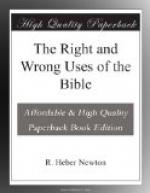The sacred literature of Israel is the record and embodiment of this organic growth of her religion, through its various moods and tenses, toward its ideal in the Christ. The sacred literature of the Christian Church is the picture of this flower of the soul of Israel, and of the new growth springing up from its seeding down of humanity. The whole Bible presents us with the growth of the religion of the Christ, below ground and above ground; its rootings and its flowerings. The right historical use of the Bible is, through a critical knowledge of the sacred literature of Israel, to reproduce before our minds this process of the growth of the Christ in Israel and of His new growth in humanity; with a view to our intelligent perception of His true place in history, and of the significance thereof. The heart of the Bible is Christ. That which our fathers saw we need to see, that in Him all things stand together, as the arch is holden by the key-stone. Rightly to read the secret of His life is to find the secret of earth’s problems. Therefore our fathers insisted so strenuously on the Old Testament preparation for Christ. A tree’s rootings are proportionate to its size. In the gradual prefiguring of Christ through Israel’s story, they read the historic attestation of His revelation. The picture of Israel’s history that yielded them their vision is dissolving before our eyes, at the touch of the new criticism, and men are fearing that the secret of the Bible is escaping from our age. I desire to-day to draw for you, in outline, the story of Israel’s development, as traced by our new masters; that you may see the old vision re-emergent in truer, nobler forms. The re-construction of Hebrew history makes real and certain an organic, natural development of the religion of the Christ; a travail of the nation with the Son it bore to God.
The best method of studying any history is in its great epochs and periods. The eras of Hebrew history group themselves clearly, in orderly progression.
I.
The Epoch of Moses: B.C. 1300(?)
Hebrew history properly begins with this era. The tribes of Israel when first resolved by the glass of history, appear upon the Arabian border of Egypt, as occupants of the rich pasture lands of Goshen. They were a branch of a large Semitic family, which included Moab, Edom, Ammon and other familiar tribes. Of the social, intellectual and religious status of the Hebrews at this period we have little definite information. They would seem to have been on the usual plane of races which have entered the semi-nomadic stage, and which are gradually substituting agricultural pursuits for a roving shepherd life. Oppressed by Egypt they revolt, and begin a migration backward toward the north and east.




